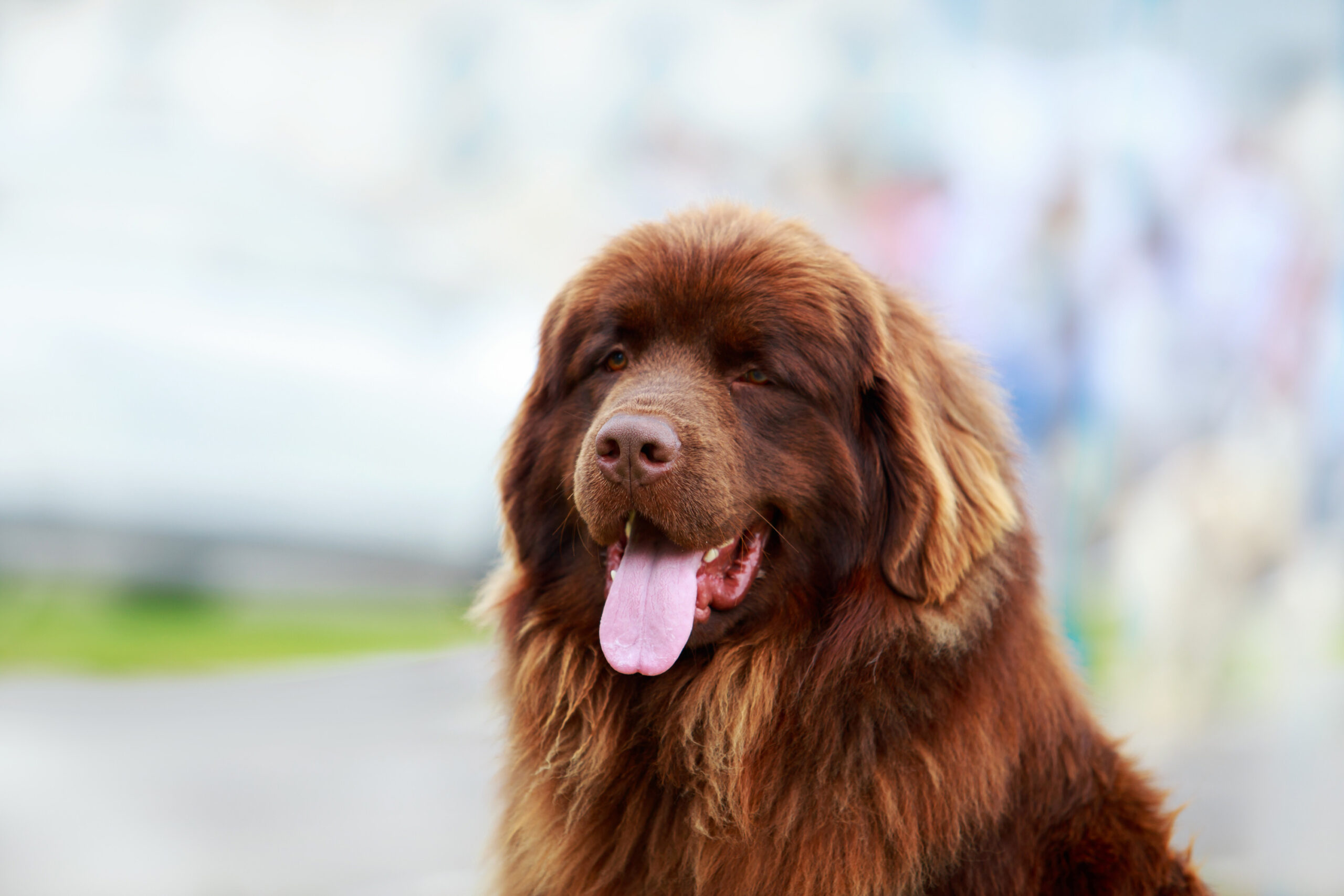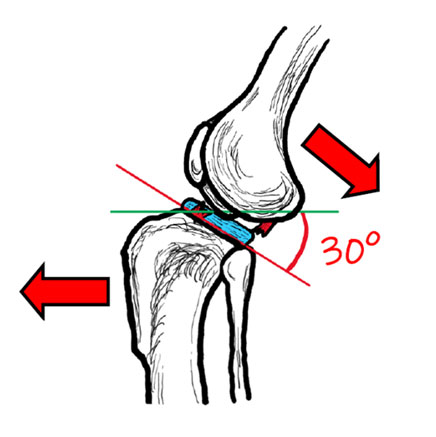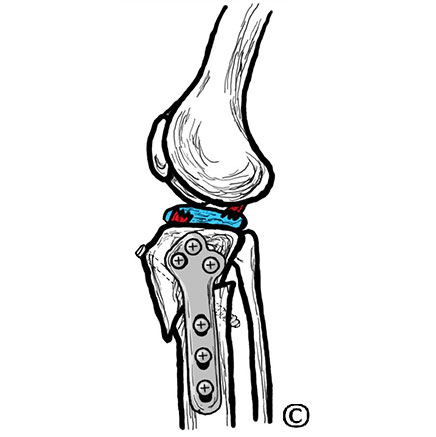CORA Based Levelling Osteotomy (CBLO)
It is a surgical procedure that involves adjusting the tibial plateau (the surface at the top of the shinbone) by cutting the bone with a purpose-made surgical saw, rotating the cut portion, and securing it in a new position with a plate and screws.

What is CBLO surgery?
How does CBLO surgery work?
CBLO surgery works to reduce the slope at the top of the tibia, so when the dog is weight-bearing, the femur rests on the tibial plateau rather than slipping backwards and pushing the tibia forwards. This prevents the sensation of the knee giving way and should remove or reduce the lameness previously seen.
CBLO surgery works in a similar way to a TPLO procedure, however, the bone cut is angled in the opposite way, which means it is further from the joint. CBLO aims to allow the leg to bear weight in a way that is closer to normal after the surgery site has healed.

Image copyright of Rebecca Jones
Image of a canine knee joint with a torn cranial cruciate ligament.
The backwards slope of the shin bone causes the thigh bone to slip backwards in relation to the shin bone (and vice versa) if the cranial cruciate ligament is unable to resist this movement. The menisci are pictured here in blue – these are cartilage structures which act as shock absorbers within the joint.
What does CBLO surgery involve?
The procedure may vary slightly depending on your surgeon, and they will be able to provide you with more specific information.
All CBLO procedures are performed under a general anaesthetic. Specialised X-rays will be collected, if they have not been taken previously, to allow surgical measurements, which can vary widely between different dogs. Your pet will likely need to have a full clip of the affected leg stretching from the ankle to the hip.
Generally, surgery will start with opening the capsule surrounding the knee joint and assessing for damage to the shock-absorbing cartilage pads that sit between the bones (menisci). If damage is seen, then the damaged portion is removed before the CBLO is performed. This may be done as an open approach or keyhole – with a specialised camera.
The tibia is then exposed and marked with measurements taken from the pre-operative X-rays. The bone is cut with a special curved saw blade, and then the cut portion is moved to a new position. At this point, a special CBLO plate and screws are used to hold the bone in place while it heals.
X-rays are taken at the end of surgery to ensure the plate and screws are in the right position and that the new angle is flat enough.

Image copyright of Rebecca Jones
Image of a canine knee joint after a CBLO procedure.
The cut portion of the shin bone has been moved and secured with a purpose-made bone plate and screws.
What does post-operative care involve?
Medication
Your dog will require a course of pain relief and sometimes antibiotics following surgery, these are typically given orally in tablet or liquid form.
Exercise
Managed exercise is beneficial during the recovery, however, this must be strictly controlled and will be significantly reduced during the first eight weeks following surgery. In the period immediately following surgery, your dog will be required to be crate-rested or confined to a small room without access to furniture to jump on and off. Your surgeon will provide you with more detailed instructions on how to manage your dog’s exercise following surgery.
Follow up visits
Dependent on how your dog’s surgical wound has been repaired a follow-up visit to your vet is often needed around two weeks after surgery, most dogs will need to wear a buster collar until this time to prevent interference with the wound which may lead to infection or opening of the surgical site.
Post-operative X-rays are usually collected around eight weeks after surgery to check healing is progressing well.
Weight control
Unfortunately, regardless of treatment (or lack of treatment), all dogs are likely to be predisposed to the development of osteoarthritis in the affected joint following cranial cruciate ligament disease, because of this it is recommended that they maintain a slim body condition. Your vet will be able to give you more information regarding weight control plans if this is required.
Hydrotherapy/physiotherapy
Hydrotherapy/physiotherapy can be useful in the postoperative period and can be considered once the skin wound has healed. Your vet can advise you if this is appropriate for your dog.
What is the prognosis following CBLO?
CBLO surgery is a relatively new technique, and as such, only a few studies have reported the outcomes of patients. One study found that 77% of dogs had returned to normal function and 19% to acceptable function, as judged by their owners after three months on average. CBLO has a very high success rate, with 90—95% of dogs regaining complete or near-complete function of the affected leg and 93% of owners reporting that they are satisfied with the procedure 12 months after surgery.
All dogs with cranial cruciate ligament rupture are expected to eventually develop at least some signs of osteoarthritis in the affected joint, but this is likely to be reduced or delayed in dogs who have had a surgical procedure.
Around 50% of dogs will develop cranial cruciate ligament disease in the other hind limb; in some cases, this requires immediate surgery, and in others, it may be many years.
What are the risks of a CBLO?
Unfortunately, complications can occur with any surgical procedure. The complication rate for CBLO surgery is low, but potential complications include:
Infection
Any surgery carries a small risk of infection. Orthopaedic surgery carries a slightly higher risk because bacteria can stick to the metal implants, which makes it difficult for the immune system to reach them. To reduce this risk, all dogs receive antibiotics during surgery. If your dog licks their wound after surgery, they can introduce infection, which is why most dogs will need to wear a buster collar until the surgical wound has healed.
Screw-loosening/Implant failure
In a small number of dogs, the screws that hold the bone in its new position can become loose over time. If this happens, excessive movement of the bone segments against one another can delay healing and, in the worst-case scenario, the plate can break and require replacement. The risk of this happening increases substantially if exercise is not sufficiently restricted following surgery.
Delayed healing of the bone
The bone needs to heal in order to become strong enough to support your dog’s normal activity. All dogs heal at slightly different rates and often patience is required. Insufficient exercise restriction after surgery, as well as some underlying health conditions, can predispose a dog to slow healing.
Subsequent meniscal injury
In some cases, the menisci appear normal at the time of surgery but are later damaged due to continued, mild degrees of joint instability. If this is the case, lameness may persist longer than expected post-surgery, or dogs may seemingly recover before suddenly becoming lame on the leg once more. If this occurs, repeat surgery will be required to inspect the meniscus for damage and cut away any torn portions. In one study, 8.6% of dogs had a late meniscal injury after CBLO.
Which dogs will benefit from a CBLO?
However, CBLO is often more expensive than other procedures and much less widely offered, which may affect your decision. It also does typically involve a much stricter period of exercise rest, with greater potential for serious complications if this is not enforced than alternative procedures such as the lateral suture.
Contraindications for surgery may include:
· Dogs who are receiving medication that suppresses their immune system and makes them likely to experience delayed fracture healing.
Contibutors
Author: Dr Catrina Pennington BVM&S MRCVS
Catrina graduated from the University of Edinburgh in 2014. After two and a half years in small animal, first opinion practice she completed a rotating internship followed by a period as a surgical registrar at Chestergates Veterinary Specialist. She returned to Edinburgh University in 2018, completing an internship in Soft Tissue and Oncological surgery before starting her current position as a Clinical Fellow in Small Animal Surgery at the Royal Veterinary College.
Editor: RCVS Knowledge Communications Team
Reviewer: Mark Morton BVSc DSAS(Orth) MRCVS
References
- Vasquez, B. et al. (2018) Second-look arthroscopic findings after CORA-based levelling osteotomy. Veterinary Surgery, 47 (2), pp. 261-266. Doi: https://doi.org/10.1111/vsu.12708
- Kishi, E.N. and Hulse, D. (2016) Owner evaluation of a CORA-based levelling osteotomy for treatment of cranial cruciate ligament injury in dogs. Veterinary Surgery, 45 (4), pp. 507-514. DOI: https://doi.org/10.1111/vsu.12472
